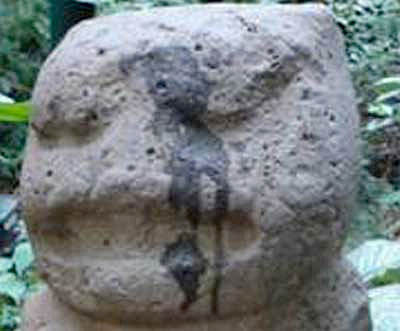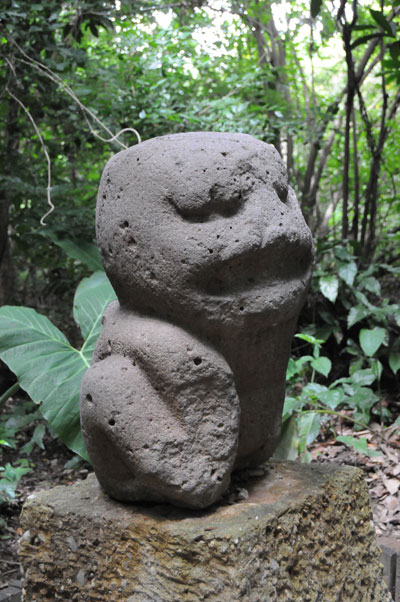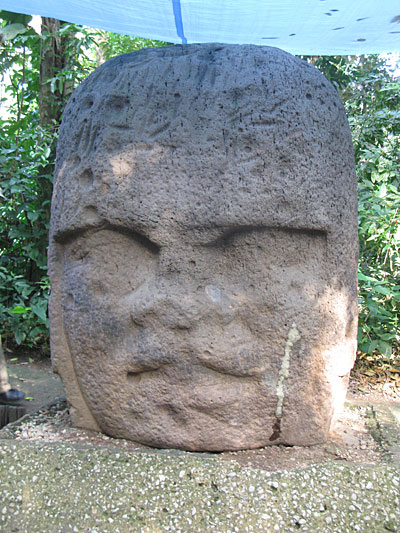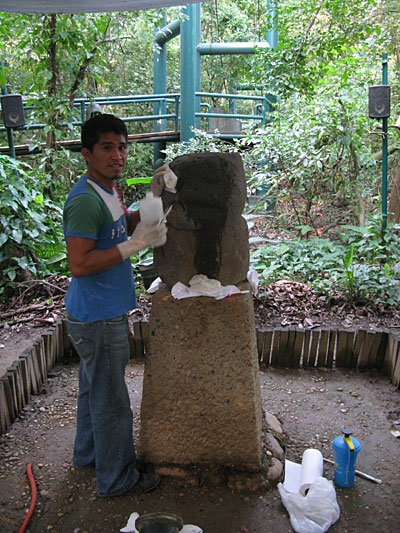

|
(January 21, 2009) Twenty-three Olmec sculptures in the Parque Museo La Venta in Villahermosa, Tabasco, Mexico, were damaged on January 11, 2009 when three individuals attempting to carry out a ritual at the park poured salt water, grape juice, and oil onto the monuments. The three vandals included Roberto Conde Díaz (30 years of age) and José Pablo Meneses (42 years of age), both Mexican nationals and pastors in an evangelical church, as well as an American citizen, Wanda Aguilar, 35 years of age. The three have been released after paying a fine of 330,000 pesos. Following many protests by Mexicans at the apparent leniency of this punishment, Mexican legislators met on January 19 to draft new laws that would increase fines and jail time for vandalism and looting of monuments and archaeological sites.
Restoration experts from the Coordinación Nacional de Conservación del Patrimonio Cultural of INAH are attempting to clean the monuments, and they estimate that the total cost of repairs will reach 300,000 pesos. Damaged monuments include the four "Colossal Heads" from La Venta, as well as many smaller pieces such as Monument 60. The park remains open but with increased security measures in place. Director of the Centro INAH Tabasco, Juan Antonio Ferrer Aguilar, has indicated that it may be necessary to replace the originals in the park with replicas, as the monuments suffer not only from risk of vandalism, but also from rain and air pollution. Ferrer Aguilar has indicated that any replicas would be made of original material (mostly basalt), carved by modern expert sculptors. This would be similar to the process carried out in Palenque's Temples XVII and XIX in recent years.
Translated from The National Institute for Anthropology and History (INAH) also stated that undertaking immediate action allowed attaining better-than-expected results and a complete removal of the oil poured on the pieces. During a visit to the park-museum this Friday, Alfonso de María y Campos, the General Director of INAH, who was accompanied by the governor of the State of Tabasco, Andrés Granier Melo, personally inspected the results of the intervention, which included a rigorous chemical analysis carried out before the intervention, for the purpose of choosing the most adequate methodology to clean the sculptures that were affected by acts of vandalism inflicted upon them on January 11th. During the visit, Lilia Rivero Weber, National Coordinator for the Conservation of Cultural Patrimony (CNCPC) explained the fine details of the intervention process begun on January 15, pointing out that "results obtained on all 23 affected monuments are optimal thanks to the swiftness with which the stains were treated. The speed of our response permitted the obtention of results that are better than the ones we were expecting during the testing phase." The specialist explained that for 20 days of non-stop work the nine-member restoration team worked on each of 23 sculptures made of basalt, limestone, and serpentine. A repeat cleansing process using several water-based sodium hydroxide solutions was used, as well as continuous washing with distilled water and applications of steam, all of which dissolved the mixture of oil, salt, and grape juice that was poured on the pieces. On each sculpture, the stained frontal areas were treated first, followed by the sides and finally the by the backside and the top. Rivero Weber also remarked that this first phase was concluded some days ago, ahead of schedule. Currently, the sculptures are being monitored for the purpose of ascertaining that there will be no more residues of oil-based substances migrating to the surface. Once this first phase of emergency intervention is concluded, stated the head of CNCPC, a second treatment phase will begin, consisting of a general cleaning process of all 23 affected Olmec monuments, for the purpose of attaining a general integration, since there is an appreciable difference in the hue of those areas where stains were removed and the rest of each piece. "This second phase is also carried out for the purpose of ensuring total removal of any remains of oil and of any chemical products used in the cleaning processes," said the restorer. Sculptures that were intervened are: the emblematic Colossal Head; the Jaguar-Child; the Tomb; the Altar of the Owls; the Standard-bearer; the Altar of the Children; the Character with a Cape; the Dolphin; the Silhouette; the Tattooed Head; the Eroded Altar; the Unfinished Head; the Dialog Altar; the Clefted Head; the Contortionist; the Old Warrior; the Young Warrior; the Basalt Column; the Young Goddess; the King; the Feline Altar; the Mosaic Mask, and the Triumphal Altar. Finally, Rivero Weber reported that a detailed diagnostic of the state of preservation of all 50 sculptures at the Parque Museo La Venta will be carried out, including the 23 pieces that were damaged last January.
At the conclusion of this first phase of restoration and cleaning of Olmec sculptures, INAH reiterates its commitment to preserving the Nation's cultural patrimony, a task that requires the participation of all the people, since it is impossible to anticipate the intentions of visitors to archaeological sites.
|
| 
|


